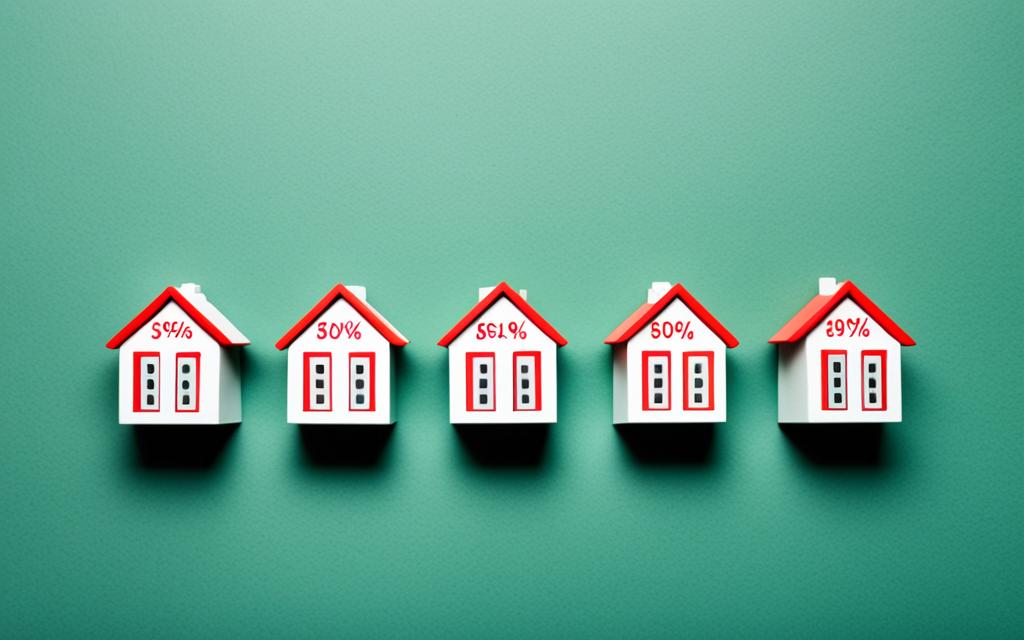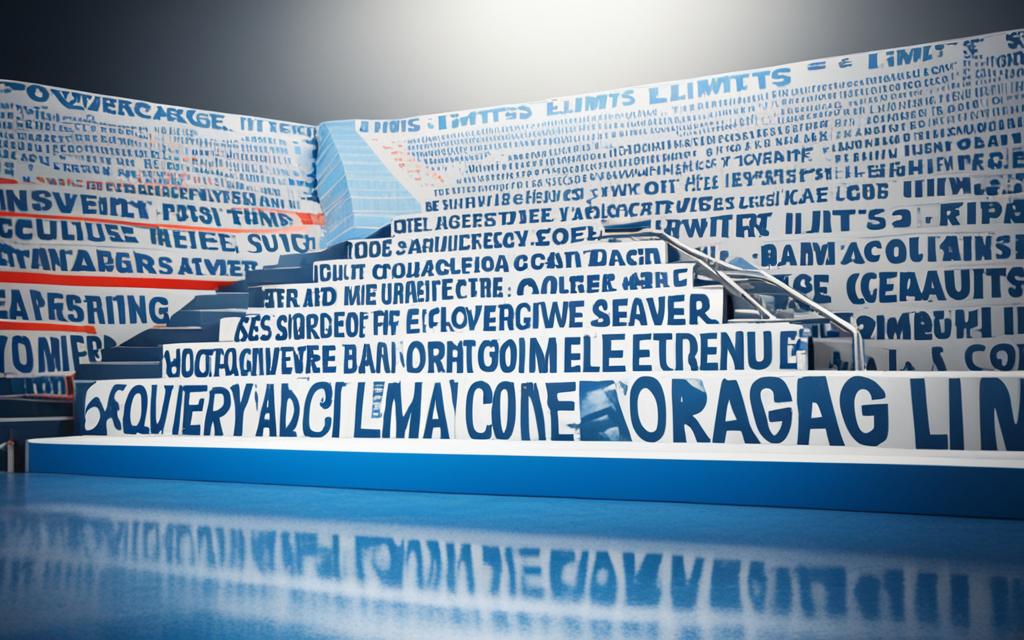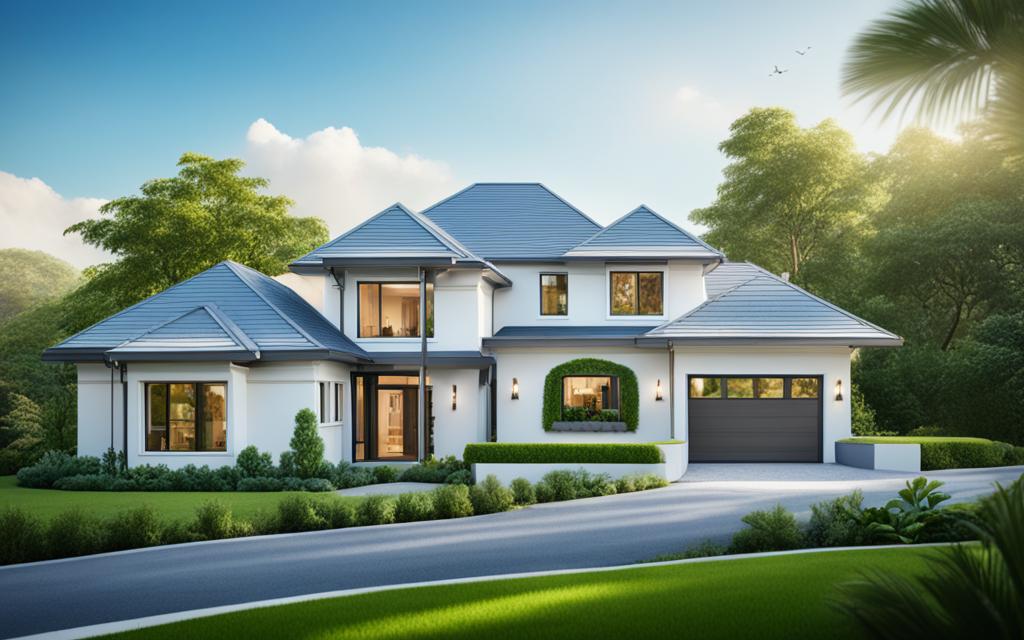Safeguarding your home is key, and high-end homeowners’ insurance brings unmatched coverage. We’ll dive into what affects insurance costs, coverage choices, and how to get more protection for less money.
Key Takeaways
- Homes valued at $750,000 or higher are considered high value in the insurance sector1
- Luxury homes with a replacement value exceeding $1 million require specialized high-value homeowners insurance1
- Increased rebuilding costs due to economic challenges can affect insurance rates1
- High-end appliances and smart home technology can increase insurance premiums1
- Liability coverage is crucial for homeowners with additional structures or business equipment1
Understanding the Factors Affecting Homeowners’ Insurance Costs
Homeowners’ insurance costs change for many reasons. The location of your home and how much it’s at risk from disasters is important2. Also, the cost to replace your property and the deductible you pick matter23.
Location and Natural Disaster Risks
The area in which your home is located affects your insurance price. Insurers look at the chance of disasters like hurricanes, wildfires, or floods. In California, homes in wildfire zones can pay 15% to over 300% extra2. Home insurance can cost more than $4,000 a year in hurricane-prone Florida2.
Replacement Cost of Your Home
What it would cost to rebuild your home is another big part of your insurance cost. Older houses might cost more to insure because their parts could be easily damaged. Also, making or fixing homes has gotten 19% costlier lately, which can push up insurance prices too42.
Policy Deductibles
How much you agree to pay before insurance kicks in will affect what you pay. Usually, if you pick a higher deductible, your overall insurance cost will be less3. But, make sure you can afford the deductible if you ever have to make a claim. Some insurance companies reward you with lower deductibles over time if you don’t have claims4.
Other things like your credit and claims history, if you’re married, and your home’s age also play a part in cost4. Knowing about these can help you choose smartly and maybe reduce expenses while keeping your home protected.
Maximizing Coverage and Protection
Our top priority as homeowners is to keep our home safe. Homeowners insurance offers many coverage options to protect our home, its structures, and what’s inside.5 Knowing about these coverage parts helps us choose the best protection for our needs.
Dwelling Coverage for Your Home
The core of homeowners insurance is the coverage for our home itself. It guards the building against losses like fire or storm damage.5 It’s key to figure out how much it would cost to rebuild your home. This ensures you have the right coverage for rebuilding entirely if needed.
Other Structures and Personal Property Coverage
Besides the home, insurance also covers structures like garages and personal property. This protects items such as furniture, electronics, and jewelry.6 For valuable items, there’s a way to get extra coverage through special endorsements.
Homeowners insurance can cover more than just the basics. It includes things like water backups and earthquakes, and even cyber risks.6 Knowing about these extras helps make sure our policy meets all our needs.
Learning what homeowners insurance covers can make us feel safer. It protects our home and everything in it from many dangers. With the right policy, we can have peace of mind.
Exploring Additional Living Expenses Coverage
As homeowners, protecting our homes is key. But disasters like natural events or fires can change everything. Our insurance can help with this, offering extra money for living elsewhere.
This extra living support is often a slice of what covers your home, maybe 20 to 30 percent. For example, if your house cover is $200,000, you could get up to $60,000 to help. It’s wise to keep records of your spending to figure out how much you might need for 30 to 60 days away.
Most home insurance plans include something for extra living costs. This helps with things like where to stay, food, storing items, and getting around if your home is ruined.7 They keep paying until you don’t need it anymore or until you hit your limit.
But, if your costs go over what they’ll cover, you might be out of luck. So, getting as much extra living help as you can is smart. Disasters don’t warn us, and living away is expensive.
It’s good to think about your ALE limits, based on what you usually spend, where you live, and how long you might be out. You might need to show proof like receipts or rental agreements to get this help.
For those in areas prone to storms, more ALE insurance might be a wise move. Replacing what’s lost after a storm can be very costly. Talking with insurance agents can clarify your options and make sure you’re covered well.
Understanding ALE benefits means you can keep living as usual even when your house is off-limits. Planning ahead and having enough coverage protects you and helps keep your mind at ease while your home is fixed.

Liability Protection and Medical Payments
We offer strong liability protection and medical payments as part of our home insurance. These cover you and your family if someone gets hurt or there’s damage on your property.8 They make sure you’re not left dealing with big costs caused by accidents.
Personal Liability Coverage
Coverage E helps if you’re legally to blame for someone getting hurt or their things getting damaged. It handles legal defense and any payments you must make.8 For example, if a guest gets hurt or your dog causes harm, this coverage has your back. It helps keep you from major money problems.
Medical Payments to Others
We also include Medical Payments to Others, or Coverage F, in our policies. It takes care of medical bills for people injured on your property, no matter who’s at fault.8 The coverage usually goes from $1,000 to $5,000 per person,9 giving a good support for minor injuries happening at your place.
Choosing our personal liability coverage and medical payments helps you sleep easier. Your homeowners’ insurance benefits will protect against big bills from injuries caused by accidents at home.89
Homeowners’ Insurance Benefits
Getting a top-notch homeowners insurance benefits plan has big advantages. It helps keep your home, stuff, and money safe.10 Usually, it covers home damage, broken things, and even theft. Plus, it helps when you have to live somewhere else because of damage.
10 This insurance can cover your things like furniture, gadgets, clothes, and gear up to 50-70% of your home’s value.10 If someone gets hurt in your home, it helps pay for their medical bills and other costs, which is called liability coverage.10 Also, if you must leave because of a disaster, it helps pay for where you stay, such as in a hotel.
11 A 2017 survey by the National Association of Insurance Commissioners (NAIC) showed people need to check their insurance more because of severe weather risks.11 The NAIC even has a free app, myHOME Scr.APP.book, to help you keep track of your stuff better.
11 The NAIC also has tips, like the Best Practices guide, and tools for comparing insurance costs, to help with getting and understanding homeowners insurance benefits.11 Their Homeowners Insurance Report has lots of useful info, including prices and potential risks, to guide you in making smart insurance choices.
10 There are different types of homeowners policies, from HO-1 to HO-8, providing various levels of property protection and personal protection.10 For example, some policies pay the full cost to repair or replace your home and things without subtracting for wear.10 Others might cover extra costs that could come up, like inflation.
10 Sadly, homeowners insurance doesn’t usually help in wars, some natural disasters, and events like floods or quakes.10 But it does a lot, like protecting your house, other structures, stuff, from major disasters to legal issues. This offers financial security for those who own homes.

Perils Covered and Excluded
Every homeowner should know what their insurance covers. Generally, homeowners insurance pays for many risks. Yet, certain events may not be covered. Knowing what’s included and what’s not helps keep our homes safe.12
Typical Covered Perils
Most home insurance plans guard against 16 dangers. This includes damages from fire, smoke, and weather. It also includes theft and some types of water damage. All of these are usually protected.12
Furthermore, policies often cover vandalism and damage by ice. Even structural harm from riots or explosions may be included.13
The insurance type you get will change what’s protected. HO-2, HO-3, and HO-5 insurance differ in what they cover. For instance
,
HO-3 often protects against 16 risks. But you can get more coverage at an extra price.12
Perils Generally Not Covered
Still, some dangers are not part of regular home insurance. This list typically includes earthquakes, floods, mold, and termites. Even wear and tear is usually not protected.12
Moreover, places with common natural disasters might need extra policies. This could be for hurricanes, wildfires, or other big threats.12
Home insurance also doesn’t help with some problems you could have avoided. For example
,
not taking care of your home can lead to mold or bug issues. This kind of damage isn’t usually covered. Neither are sewer problems or costs from new building rules.1213
Always check what your policy doesn’t cover. This way, you know what risks you might face alone. You may think about getting more protection for these gaps.1213
Discounts and Cost-Saving Strategies
We all know our homes are our biggest investments. Keeping them safe is key. But, the price of insuring our homes can be high. Luckily, there are ways to lower costs and get the most for our money.
Home Security Features
Investing in home security features is a smart move.14 Things like smoke detectors, burglar alarms, or deadbolt locks can lower your insurance costs. By improving our home’s safety, we show we’re reducing insurance risks. This can lead to cheaper rates.
Bundling Policies
Bundling home and auto insurance with one provider can save money.14 This move can cut your homeowners’ premium by 5% to 15%. It makes handling insurance easier and gives access to more discounts.
Maintaining Good Credit
Our credit score matters for insurance costs.14 Bad credit can raise your rates by up to 73%. Keeping a strong credit profile shows insurers we’re responsible. They might then offer us cheaper policies.
Also, remember that15 policy prices differ between insurance companies, sometimes by hundreds. It’s wise to get quotes from three or more insurers. This ensures you’re not overpaying. Raising your policy’s deductible can also lower your premiums. Plus, staying with the same insurer for a long time can get you discounts.
By using homeowners insurance discounts and cost-saving strategies like adding home security features, policy bundling, and keeping good credit, we can manage our insurance costs. This way, we can protect our homes cost-effectively.

Renters and Condominium Insurance
This guide has talked a lot about homeowners insurance. But, it’s key to know that renters and condominium owners need their own insurance. Renters insurance covers your stuff and protects you if someone gets hurt at your place. Condominium insurance looks after the inside of your unit and gives you liability coverage too.8
Renters insurance is great for keeping your personal property safe. It helps you get new things if they’re stolen or wrecked by things like fire or vandalism.8 Also, condominium insurance protects your things and any improvements you’ve done in your unit.16
Both renters and condominium insurance include liability coverage. This part is big – it helps if someone is hurt at your place and you’re held accountable. It pays for medical bills and legal costs so your finances stay safe.8
| Coverage | Renters Insurance | Condominium Insurance |
|---|---|---|
| Personal Property | Covers your personal belongings | Covers your personal belongings and any upgrades to your unit |
| Liability | Provides coverage for accidents or injuries on the property | Provides coverage for accidents or injuries on the property |
| Additional Living Expenses | Covers temporary housing and other expenses if your rental is uninhabitable | Covers temporary housing and other expenses if your condo is uninhabitable |
It’s smart to know what renters and condominium owners need in their insurance. This way, you make sure your things, liability, and living costs are safe if something bad happens.16
Determining Adequate Coverage Limits
Choosing the right coverage limits in our home insurance is key. This protects our home, things, and money if something goes wrong. Usually, policies cover about 50 to 70 percent of your house’s insurance for your stuff17. This makes it vital to think about how much it would cost to replace our home and belongings. Paying a bit more for replacement cost coverage for belongings is smart. It often pays off in the long run17.
We don’t just need to cover the house. Looking at how much our personal property is worth and adjusting limits is also crucial. Insurers might limit how much they pay for items like jewelry18. So, knowing these rules and getting extra liability protection is important. In some cases, there could be caps on how much they’ll pay for things like computers17.
Liability coverage matters too. It’s smart to boost the standard $100,000 coverage to $300k or $500k for better liability protection17. Adding umbrella liability insurance can give even more coverage. But, your regular home policy must have at least $300k liability to get this extra coverage17.
Thinking through our coverage limits, replacement cost values, and liability protection is key. This ensures our home insurance truly protects our biggest assets and financial health.

Navigating the Insurance Marketplace
Finding the right homeowners insurance policy might seem hard in the insurance marketplace. Yet, with the right steps, it doesn’t have to be. Exploring various policies and talking to insurance brokers and agents can help. It allows us to make a smart choice that fits our needs and budget.
Shopping Around
It’s key to compare what different insurers offer to meet your needs and budget well. It’s important to look at the types of coverage and their costs. These include ACV, replacement cost, and guaranteed replacement cost/value. Each has its benefits.
Looking at these options helps us choose wisely based on our needs and risks.
Working with Brokers and Agents
Teaming up with insurance brokers and agents brings great advantages. They know a lot about the industry. They can help us find the best coverage at a good price.19 Things like home upkeep and certain dog breeds can affect what you pay. Your broker or agent will explain this and suggest ways to lower your costs.
With help from insurance brokers and agents, identifying the right policy is easier. They make it easier to compare different plans. Ensuring you pick a policy that fully protects your home and possessions is crucial.19 It’s advised to have at least $300,000 in liability insurance. There’s also an option to increase this up to $1 million or more with an umbrella policy. This amount of coverage offers peace of mind against unforeseen events.
Conclusion
Homeowners insurance is key in protecting your home, a crucial asset. Understanding factors like location and deductibles helps us make smart choices. This ensures our homes and belongings are well-covered20.
Different types of coverage exist. These range from protections for your house to living expenses if you need to move out. You can mix and match these to suit your needs. And, to save money, think about combining policies or using smart home tech.
Your home is your biggest investment. It’s vital to know what your policy covers and what it doesn’t. Sometimes, you might need extra coverages. Working with experts and comparing different offers can help you get the best deal. This way, you can protect your home and everything in it21.
FAQ
What are the key factors that influence the cost of homeowners’ insurance?
What coverage options are available in a homeowners’ insurance policy?
What is additional living expenses (ALE) coverage?
What liability protection and medical payments coverage does homeowners’ insurance provide?
What are the typical perils covered and excluded by homeowners’ insurance policies?
How can I save money on my homeowners’ insurance premiums?
Do renters and condominium owners have specific insurance needs?
How do I determine the appropriate coverage limits for my homeowners’ insurance policy?
How can I effectively navigate the homeowners’ insurance marketplace?
Source Links
- https://www.cbiz.com/insights/articles/article-details/high-value-insurance-protect-your-luxury-home-contents-property-casualty
- https://www.experian.com/blogs/ask-experian/factors-that-impact-homeowners-insurance-costs/
- https://www.dfs.ny.gov/consumers/help_for_homeowners/insurance/understanding_what_affects_the_cost_of_insurance
- https://www.bankrate.com/insurance/homeowners-insurance/factors-that-impact-home-insurance-rates/
- https://bassineinsurance.com/maximizing-your-home-insurance-coverage/
- https://www.truviewinsurance.com/blog/maximizing-protection-top-homeowners-insurance-add-ons
- https://openly.com/the-open-door/articles/additional-living-expenses-coverage
- https://www.insurance.ca.gov/01-consumers/105-type/95-guides/03-res/res-ins-guide.cfm
- https://www.forbes.com/advisor/homeowners-insurance/medical-payments-coverage/
- https://myacis.com/home-insurance/top-10-benefits-of-homeowners-insurance/
- https://content.naic.org/cipr-topics/homeowners-insurance
- https://www.bankrate.com/insurance/homeowners-insurance/what-is-an-insurance-peril/
- https://www.mercuryinsurance.com/resources/home/perils-covered-by-homeowners-insurance.html
- https://www.nerdwallet.com/article/insurance/save-on-homeowners-insurance
- https://www.iii.org/article/how-to-save-money-on-your-homeowners-insurance
- https://interactive.web.insurance.ca.gov/apex_extprd/f?p=143:1:
- https://www.iii.org/article/how-much-homeowners-insurance-do-you-need
- https://www.bankrate.com/insurance/homeowners-insurance/how-much-homeowners-insurance/
- https://www.investopedia.com/insurance/homeowners-insurance-guide/
- https://www.travelers.com/resources/home/insuring/do-i-need-homeowners-insurance-and-when-should-i-buy-it
- https://roughnotes.com/homeowners-policies-the-conclusion/

